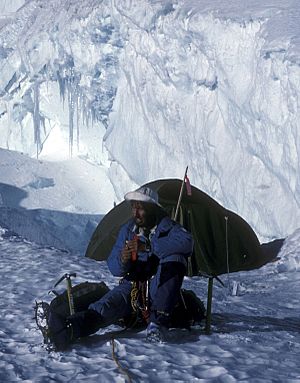Matthias Kuhle facts for kids
Quick facts for kids
Matthias Kuhle
|
|
|---|---|

Matthias Kuhle (Everest north slope, Central Rongbuk Glacier)
|
|
| Born | April 20, 1948 |
| Died | April 25, 2015 (aged 67) |
Matthias Kuhle (20 April 1948 – 25 April 2015) was a German geographer and professor at the University of Göttingen. He edited the book series Geography International published by Shaker Verlag.[1]
Kuhle died on 25 April 2015 in a major earthquake in Nepal.
Education and career
Kuhle studied German philology, geography, and philosophy at the Free University of Berlin. He graduated in 1972 (Staatsexamen) and moved to the University of Göttingen for Ph.D. work. His Ph.D. in the natural sciences (Dr. rer. nat) was conferred in 1975 for work on geography, geology and philosophy. His Ph.D. dissertation was a monograph on the geomorphology and former glaciation of South-Iranian high mountains. In 1980 he achieved his habilitation in Geography with a monograph titled Dhaulagiri- and Annapurna Himalaya: A Contribution to the Geomorphology of Extreme High Mountains. He was appointed Professor of Geography at the University of Göttingen in 1983, and promoted to the chair for Geography and High Mountain Geomorphology in 1990.
His main areas of research were the mountain ranges and plateaus of High- and Central Asia, the Andes and the Arctic. Since 1973 he undertook several multi-months research expeditions.
Kuhle's priority program of research was High Mountain Ecology, Periglacial and Glacial Geomorphology, Climatology, Ice Age research (Paleoclimatology), Glaciology and Science Theory. His work focusses on the reconstruction of the former ice cover of High and Central Asia, caused by the plate tectonic-induced uplift of the Tibetan Plateau and surrounding mountain areas above the snowline. His theory of Ice Age Development during the Pleistocene is based on this reconstruction and his measurements of radiation energy and budget in subtropic areas of high altitude. Kuhle's idea of an ice sheet covering practically the entire Tibetan Plateau has been opposed by several glacial geologists (cf. Derbyshire et al. 1991; Rutter 1995; Zheng and Rutter 1998; Owen et al. 2005; Lehmkuhl and Owen 2005). These doubts however ignore earlier geomorphological evidences and are based on uncalibrated numerical datings, which up to now lack a reliable calibration technique.

